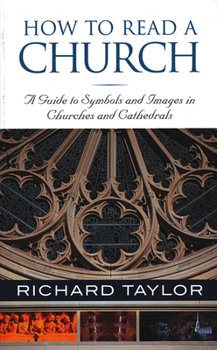How to Read a Church: A Guide to Symbols and Images in Churches and Cathedrals
Select Format
Select Condition 
Book Overview
Churches and cathedrals were originally built to be read. They are alive with images and symbols--all of which are packed with meaning. But today few people, from regular visitors to tourists, truly understand the wealth of meaning in what they find there. How to Read a Church is must reading for anybody who wants to know more about what they see in a church or cathedral. It explores the principal features of churches and what each represents. It also explains: " the significance of church layout " the importance of such details as the use of colors or letters " the identity and significance of people and scenes " the symbolism of animals, plants, colors, numbers, and letters " the meaning of it all In addition to exploring these brick-and-mortar motifs, the author also reveals fascinating and unexpected details such as how to 'read' the priest and the congregation, and he shows the varied ways that church architecture and appointments reflect the Christian year. From major themes to small but vital details, How to Read a Church will serve as a fascinating guide to the history, meanings, and messages of these beautiful buildings and the treasures they contain. +
Format:Paperback
Language:English
ISBN:1587680300
ISBN13:9781587680304
Release Date:July 2005
Publisher:HiddenSpring
Length:256 Pages
Weight:0.77 lbs.
Dimensions:0.7" x 5.1" x 8.1"
Customer Reviews
5 ratings
How to read a church
Published by Thriftbooks.com User , 16 years ago
A very useful book for teaching purposes and giving an understanding of many church items
Reading a church
Published by Thriftbooks.com User , 17 years ago
Well written and organized. I learned a lot. Potential buyers should know that the focus of this book is on Anglican and Catholic churches. I'd recommend it very highly.
Interpreting art and architecture
Published by Thriftbooks.com User , 17 years ago
Ever wonder why some saints in paintings and sculpture have square haloes? Why columns have foliate capitals? And what are all those hand signals? Richard Taylor explains in How to Read a Church, written not as a scholastic thesis but as a general guide for lay persons. The basic layout of churches, the number and placement of stained glass windows, the grouping of figures and how to identify who's who - all of this can be helpful in figuring out what the builders and decorative artists were trying to convey to those viewing and appreciating the results of their labors. The book works as a resource, and does not have to be read from cover to cover. Individual chapters, such as that on styles of crosses, can be read separately and perused at leisure. Nice resource.
Terrific resource
Published by Thriftbooks.com User , 18 years ago
Taylor's book is a terrific resource explaining a much misunderstood subject. Churches are indeed designed to be 'read'; to be, in the words of another reviewer, "a feast for the senses." Taylor explains that classical church architecture reflects the understanding that a church is a ship (the word 'nave,' referring to the interior of a church, is from the Latin 'navis' for ship) sailing the faithful to a New Jerusalem, led by their 'captain' priest. Rich eucharistic symbols like the pelican, a bird which feeds its young with its blood, are explained in detail. Were more people to absorb the lessons of this book, we perhaps would see an end to the artless, crude church designs that have dominated over the past 40 years.
Point of Clarification
Published by Thriftbooks.com User , 18 years ago
I've not yet finished the book, but early on Mr. Taylor mentions that the "Catholic Church 'banned' the Latin Mass in order to increase participation by the laity. Whatever the high points of this book may be, the Church never "banned" the Latin Mass. In fact, the Second Vatican Council, which ALLOWED for some parts of the mass to be translated into the vernacular, also encouraged local parishes to catechize (educate) their members in the basic Latin prayers of the Mass so they could participate. It appears that it was easier to translate the mass into dozens of different languages than it was to get Catholics to learn a few phrases and prayers in Latin. At any rate, the Latin Mass is still celebrated with great enthusiasm and beauty in parishes all over the world (unfortunately some of them are schismatic, but many are in communion with Rome). As for the vernacular mass, "full and active participation" is a rarity in most parishes. Pope Benedict has reiterated this call for Catholics to learn some of the basic prayers in Latin so that in this truly global society we may pray together with one voice. Back to the book - Mr. Taylor's premise is dead on; Churches were meant to be read - to create a feast for the senses and create an atmosphere of awe and sanctity. i look forward to finishing the text, and perhaps using it as a textbook for a class.






